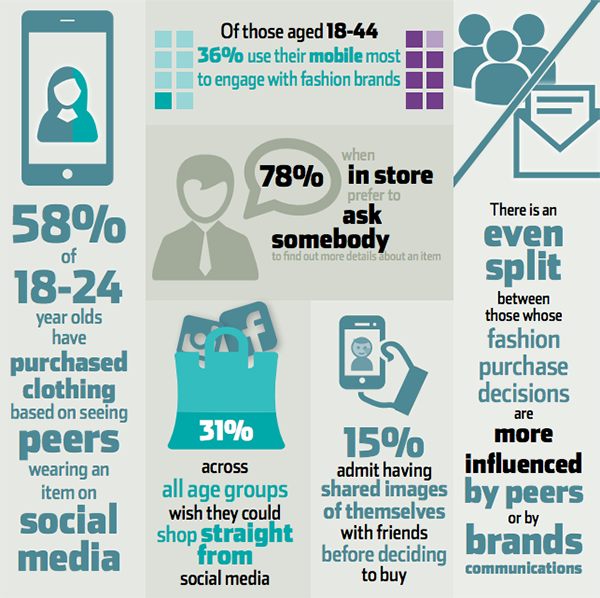Clearly, fashion retail is approaching a tipping point. Every day, the influence of millennials as mainstream consumers is growing, irreversibly changing the way customers expect to buy and be serviced.
That shift has already pushed fashion to the forefront of omnichannel retail – realising that online and offline sales are not in conflict, but need to work together to provide a seamless experience in this new 'digical' world. But consumers want more.
Connecting with today's fashion consumers
We were delighted to help produce Retail Week's Connecting With Today's Fashion Consumers report, benchmarking the sector’s progress in connecting with modern consumers in whole new ways.
1,750 UK-based consumers completed a detailed survey on their fashion shopping habits and expectations. The results were fascinating, and made two things clear: there are four key areas where retailers need to raise their game; and for those that get it right, the reward will be huge.
Here's a quick snapshot of some of the findings, but read on for more detailed insights below...

Eyes on the prize
A brief glance at the Retail Week report shows the importance of giving shoppers a seamless, joined-up experience:
- Three quarters of all fashion shoppers discover new fashion trends online.
- More than half of consumers under 34 like to receive email from their favourite fashion brands.
- Social media referrals are worth almost £10bn of fashion business.
- 72% of 18-24 year olds and half of 25-34 year olds want to be able to shop straight from their social media platform.
Crucially, though, the research also shows shoppers value human interaction from well-informed staff in-store. The challenge facing fashion retailers is to bring digital and in-person shopping together, and four aspects will be critical.
1. Convert online research into in-store sales
Digital brand strategist Caroline Homlish described the experience of many of today’s fashion shoppers: “I’ve been trying to buy a dress for a wedding, and researching online. The products I’ve visited are following me everywhere – on Facebook, when I check the weather, in my inbox. But then I visited the offline store and I couldn’t even find the dress on the rack. No one knows who I am, no one knows I’ve been looking at all of the products ahead of time.”
With so many customers looking to online media for inspiration before trying and buying instore, retailers urgently need to find better and more creative ways to make it quick, easy and fun to do.
Digital retargeting techniques are now commonplace is the fashion industry, and retailers now need to strike the same kind of balance between online and offline – making smart use of technology to give a good experience and encourage a sale, without making the customer feel that they’re being stalked.
2. Supercharge shop-floor staff
Customers like human interaction. Almost eight out of ten shoppers who need more information about a product will seek out a sales adviser first.
But with such detailed information, product reviews, advice and trends online, retailers face a tough job ensuring in-store staff are as engaging and well-informed as their own website.
Millennials in particular notice the disparity: 70% of 18-24 year olds want fashion brands to be more creative with service in store. Significant numbers across all age groups resort to browsing a brand’s website from their mobile device while in store – revealingly, far more than would use a digital kiosk.
Fashion retailers have an opportunity to stay one step ahead by giving in-store associates fast access to the wealth of information they build up online, to help them make better, more creative recommendations.
3. Harness one-to-one relationships
Where online and offline shopping are seamless, the personal interaction customers enjoy needn’t be limited to visits in person.
Increasingly, brands are giving in-store associates the technology to continue the conversation with customers online, showing them further ideas and looks, and alerting them to new products based on previous discussions – whether by text, email, call or FaceTime.
Over time, relationships develop and brand loyalty grows – combining the best aspects of digital technology and old-fashioned, personal customer service.
4. Let customers buy how they like
Stock visibility – knowing where every product is at any given time – is vital to give customers the flexibility to buy how they want – so online shoppers can reserve in store, and customers order online from the shop.
That’s why retailers like Gap have scrapped their legacy systems and put everything online, so ecommerce and transactions in store all use the same system for a genuinely seamless experience.
Some brands – like Anthropologie and Nordstrom Rack – go a step further, and give in-store staff access to an online checkout via a hand-held mobile device, letting them “queue-bust” by enabling shoppers to buy on the spot.
Now’s the time
Fashion consumers do not see themselves as online or offline shoppers – perhaps they never have. They simply want to find the styles they like, from the brands they love, and buy them as easily as they can.
Omnichannel is the key to making that happen. Fashion retailers are already leading the way – and it is only a matter of time until someone makes the breakthrough, and creates the seamless experience we all want when we go shopping.
Download the full Connecting With Today's Fashion Consumers report, with our compliments – and see for yourself how the fashion retail industry is responding to the omnichannel challenge.








